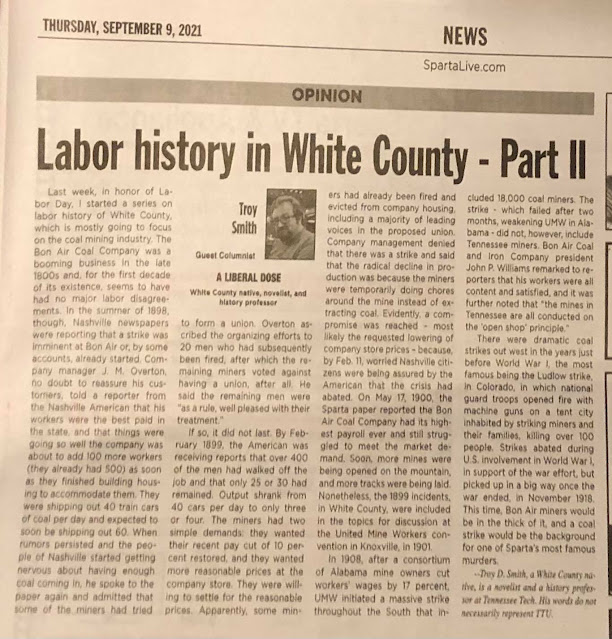A Liberal Dose
September 23, 2021
Troy D.
Smith
“Labor
History in White County, Part 4”
(see Part 1 HERE, Part 2 HERE, and Part 3 HERE)
This week I am going to conclude my series on labor history
and coal mines, but will go outside the county line. I am speaking of the 1932
strike at the Wilder and Davidson mines, which employed about 600 men. The
mines were located in the region where Fentress, Overton, Cumberland, and
Putnam Counties come together. The Wilder and Davidson mines (and company
towns) were in Fentress County, and a couple of smaller mines were across the
county line in Overton. The Wilder mine, operated by the Fentress Coal and Coke
Company, was named for the company’s founder, whom we mentioned in Part 1 of
this series: Union general John Wilder, who was opening up mining operations in
the Upper Cumberland at roughly the same time as White County’s Confederate
general George Dibrell.
Like the miners in Bon Air, the Wilder-Davidson miners had
formed their own local union and gone on strike in 1919 and 1924. As in White
County, the miners came out of the 1924 strike worse than they had gone in. In
1931 they joined the national United Mine Workers of America and their local,
4467, negotiated a one-year contract with the owners on July 8, 1931. When it
expired, the owners refused to extend it and instead cut wages for the third
time, and on July 9, 1932 the miners went on strike. With the exception of one
Danish immigrant, all the miners were Upper Cumberland natives, including their
leader Barney Graham.
In essence, the situation got much worse than it had in
White County but not as bad as in West Virginia -but, still, plenty bad enough.
Workers were evicted from company housing, and new (non-union) workers were
hired to take their place. Strikers, scabs, and company security clashed repeatedly
over the following year. As the
Tennessean put it on May 7, 1933, there were “barn-burnings, dynamitings,
shootings from ambush, fights, and neighborhood coolnesses.” The national guard
was called in. Relief organizations from around the country sent food,
medicine, and clothing to the miners.
On April 30, 1933, Barney Graham came into the company town
of Wilder to pick up medicine for his sick wife. While he was walking down the
street two company guards, Shorty Green and Doc Thompson, approached him from
behind and opened fire on him. Graham was shot in the back ten times, and the
back of his skull was crushed by rifle butts. Doctors determined that the head
injuries alone would have killed him. The killing was ruled self-defense. The
murder took the wind out of the miners and their determination to continue the
strike, and it soon ended- but there were unforeseen consequences.
One was that Graham became a national labor hero. His
daughter wrote a song about him, “The Ballad of Barney Graham,” which was later
recorded by Pete Seeger. “Although he left the union he worked so hard to
build,” the song concludes, “his blood was spilled for justice, and justice
guides us still.”
The other consequence was the effect Graham’s death had on
his good friend Myles Horton. “If I wasn’t a radical before that,” Horton later
said, “I became one then.” In 1932, Horton had established Highlander Folk
School in Monteagle. He was one of the people who came to the mines bringing
relief supplies, and reported on events throughout the strike. After Graham’s
death, Horton redoubled his efforts to make his school a place to train union
workers in nonviolent organizing. In 1955, MLK and Rosa Parks -amid efforts to
start a bus boycott in Montgomery -attended Horton’s classes, and Horton became
an active participant in the civil rights movement.
I’ve told you these stories to show what a long history
union organizing has had here, and the struggles workers have gone through. It
should never be forgotten. In my opinion, in the Upper Cumberland we should
start calling Labor Day Barney Graham Day.
--Troy D.
Smith, a White County native, is a novelist and a history professor at
Tennessee Tech. His words do not necessarily represent TTU.
A complete list of Liberal Dose columns can be found HERE
A list of other historical essays that have appeared on this blog can be found HERE
Author's website: www.troyduanesmith.com
The author's historical lectures on youtube can be found HERE




